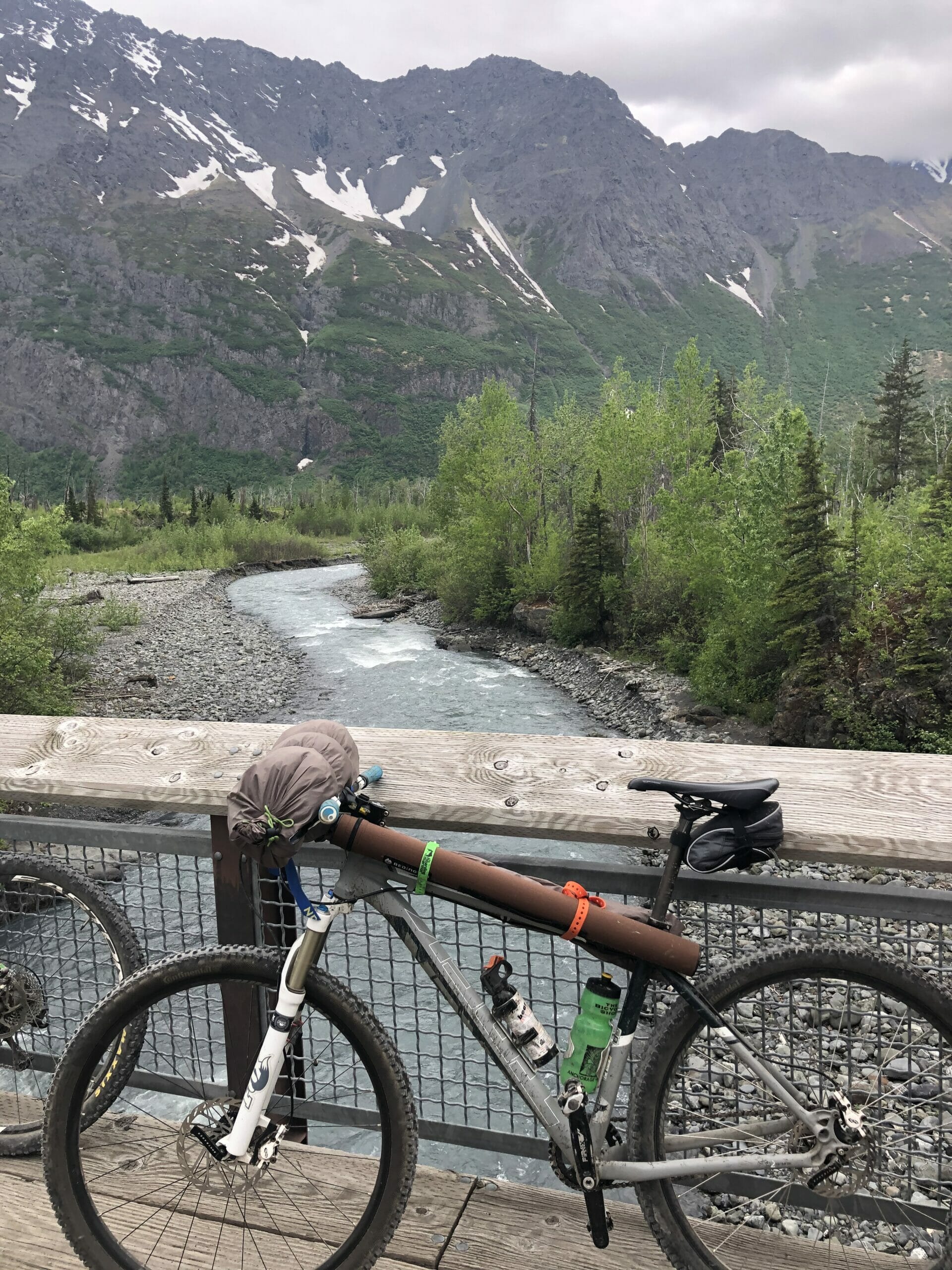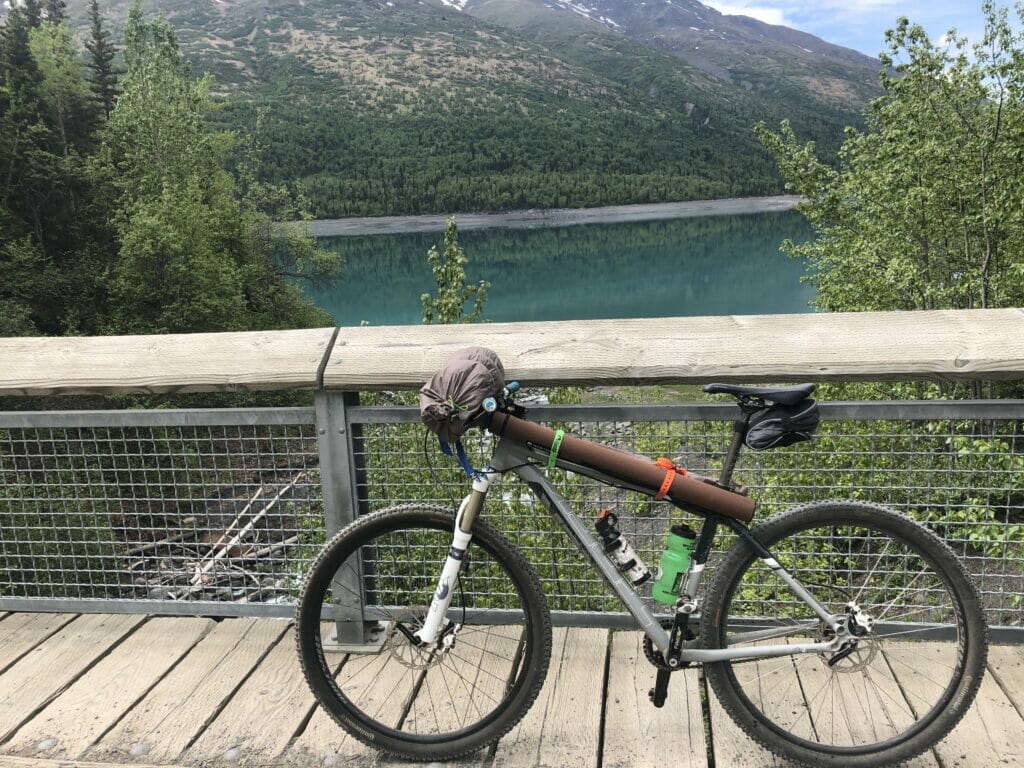As I dedicate more of my time with Trout Unlimited to help restore the Eklutna River, traditionally named Idlughetnu, I spend hours of the day with my mind 45 miles away from my Anchorage home within the fractured Eklutna River system. Though I now get to see more of the area and further my understanding of its history, there is no shortage of information I have yet to learn and areas of the watershed that I have yet to visit. As such, I’m eager to expand my knowledge of the area, dig deeper into the watershed, and gaze upon, set foot, and be present in the pieces of the puzzle I have yet to experience firsthand.
This year has been wholly unpredictable. I am one of the many Alaskans reverting to the solace of the wild country, where — while life may still be unpredictable — there is room to breathe and explore. Mountains, woods, alpine tundra and rivers are in my DNA. In their presence, they captivate. In their absence, they beckon. In idle time my mind cooks up how to return to their freedom. Excessive daydreaming can be confused as unproductive; however, I submit that when it soothes your tense mind, fuels inspiration and translates to action, daydreaming is exceedingly productive.
A product of routine daydreaming and quest for firsthand experience, I cooked up a summer goal.
The Eklutna bike-packing adventure
At the end of May, a crew of spirited friends and I coasted out of Eklutna Lake campground with trimmed packs, tents and miscellaneous items strapped to our bikes, bound for the head of the glacial valley … or at least its vicinity. It was a fresh adventure for all, and for me, the opportunity to witness the East and West Forks of the Eklutna River beyond Eklutna Lake and set eyes on the glacier, where the Eklutna River begins.
The many users of Eklutna
The Eklutna basin is the historical land of the Eklutna Dena’ina people and culturally important to the native village of Eklutna, whose ancestors inhabited the area subsisting off salmon, moose, berries and more. The basin is tucked up in the mountains of Chugach State Park, a hub of beauty and recreation and the backyard for wandering souls of Anchorage and the MatSu Valley.
The Eklutna Lakeside Trail, which parallels the northern edge of the lake, offers stunning views and is an easy trail enjoyed by hikers, runners and cyclists of all ages. The Eklutna Lakeside Trail is primarily comprised of a historic dirt road built in 1940s by the U.S. military to access Eklutna Glacier for winter warfare simulation. The trail now includes single track offshoots for non-motorized users. The Lakeside Trail is 12.7 miles one direction, and with minimal elevation gain or obstacles, recreationists can travel seemingly forever. Here’s a great tip about trail access: the Eklutna Lakeside Trail is open to motorized users Sunday through Wednesday, so plan your adventure accordingly and be courteous to other users.
The narrow, steep drive up Eklutna Lake Road unconsciously parallels the river, passes the canyon where the original hydro dam stood until recently, and the Anchorage Water & Wastewater treatment facility. The pavement ends at Eklutna Lake where emerald waters dominate the long and narrow valley in a manner that demands attention. Suffice to say that in the Eklutna Valley, Eklutna Lake sits in an impressive proportion as the centerpiece, bending its way out of view and creating an illusion of infinity. I have to think that for many, this is where their understanding and journey of the river stops as it is easy enough to see the expansive lake and think, “This is it, the source of the river,” without considering what lies beyond it.
The water that embodies Eklutna Lake once carved the path of the Eklutna River and supported a healthy salmon fishery, but is now fully contained and used in a peculiar way that is unknown to many. Of the water that makes its way into Eklutna Lake, 90 percent goes to generating less than 6 percent of southcentral Alaska’s electricity and the remaining 10 percent comprises the majority of Anchorage’s drinking water. In other words, 100 percent of Eklutna Lake water is diverted for human use, while 0 percent of the water is allowed to travel its historic path down river in support of fish.
For migrating fish, Eklutna Lake is a ‘no swim zone’ for two reasons. The first being that no fish passage exists around the embankment dam at the lake’s outflow. The second is that, though the path of spawning salmon was blocked for nearly a century by an abandoned hydroelectric dam, which has been removed thanks to the leadership of Eklutna Inc. and The Conservation Fund, fish still cannot access the recently reconnected river, or even reach the lake, simply because there is insufficient water for them to do so.
Sizing up the fishing potential and setting up camp
Two thirds of the way into our journey, having already put my past points of familiarity in the dust, the head of the lake came into view. The valley cradling its waters opens into a welcoming floodplain rimmed in stark, snow covered peaks and dotted with the charred remains of a 2010 fire that contrasts with the vibrant green of spring fertility.
Having reached the far side of the elongated, 6-mile lake, our basecamp and the heart of my personal curiosities grow near.
There are three small campgrounds and a public use cabin at the head of the lake and beyond. Unsure what competition from fellow non-motorized users would be, we committed ourselves to Kanchee Campground, furthest from the lake and closest to the glacier, with fingers crossed there would be an open spot.
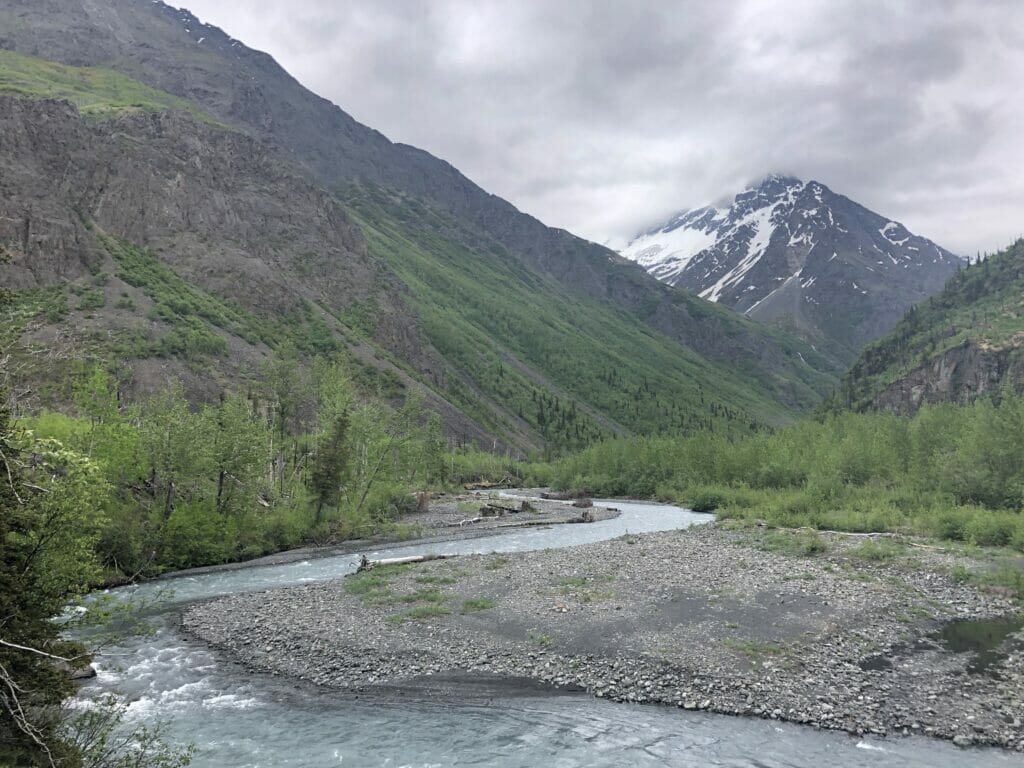
Riding onto the welcomingly smooth surface of the bridge, I cruised to the railing and dismounted my bike to scout the river below. I had never seen the East Fork of the Eklutna River — not even in a photo. Somehow, the small river looked absolutely familiar. With enchanting blue water winding past gravel bars, flowing over riffles and into deep pools, the East Fork looks unmistakably like the iconic Alaska salmon streams I fish every summer. I immediately began sizing up where I’d cast first. From the quick observation of an angler and armchair biologist, I knew salmon would thrive in this stream if they could access it.
While our crew carried no expectations, we were quite pleased rolling into the empty Kanchee Campground, and not just for the opportunity to put the packs down for a rest, but because we were impressed to find ourselves in a very legitimate Alaska State Parks Campground complete with fire ring, table, bear vault and latrine. Surveying the lavish site made us momentarily forget the sweat equity we had invested to claim our evening’s spot. With dark clouds building, we quickly built camp knowing that the forecasted spring showers were about to join the party.
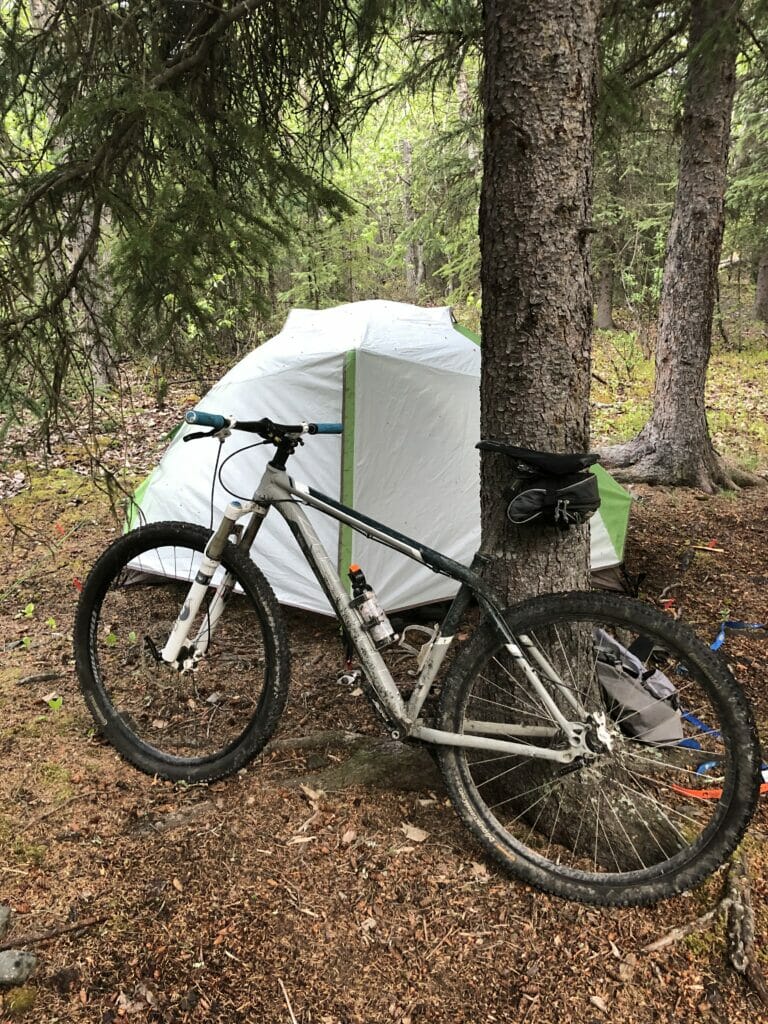
Spotting the West Fork
Air chilled and cold rain falling, it took more than a little convincing to even consider abandoning our impressively dry spruce tree canopy. But not having yet crossed the West Fork, or caught a glimpse of the glacier, the day’s intended adventure wasn’t over. I dug through my pack and fetched my rain pants. Already 11 miles into our trip, the remaining 1.7 miles to the end of the road felt absolutely feasible.
Near the Serenity Falls Public Use Cabin, we were confronted by the second fork. From the vantage point of the bridge over the river, I paused to commit to memory the West Fork of the Eklutna River. While very much the opposite of its emerald neighbor, the silt laden waters of the West Fork, surrounded by steep ridges, waterfalls and thick brush, are fitting. Together, these forks of the Eklutna River with their combined glacial yin and yang, create Eklutna Lake, provide a small amount of the area’s electrical power and the water that runs through the taps in my home. Upon seeing these rivers for the first time, I already felt a bond with them.
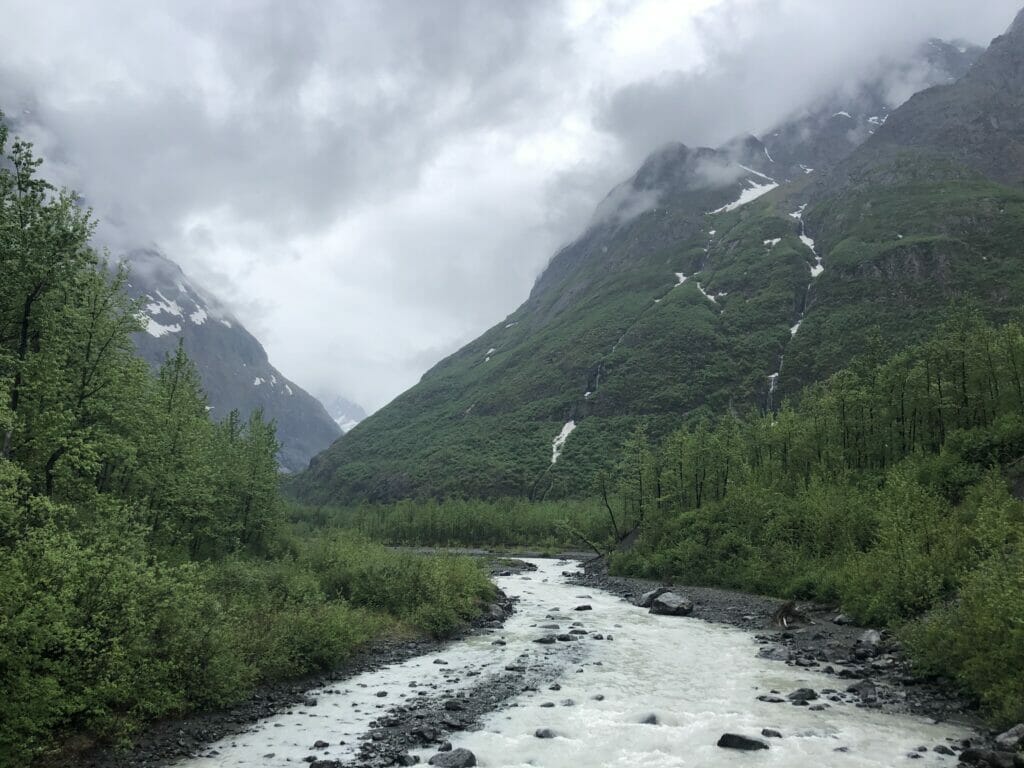
Strewn with sand, cobble and larger rocks, the road had gotten more challenging to ride gracefully with tired legs. The West Fork valley continues to constrict and the road ends at the first moraine. I stopped pedaling and couldn’t help but wonder how long ago was it that the Eklutna Glacier reached this spot. One hundred years? Two hundred? Five hundred years?
False summits to Eklutna Glacier
Stashing our bikes, we embarked from there on foot. Eklutna Glacier wasn’t within eyesight yet and the unique landscape and our curiosity drew us further. The light rock scrambling and bushwhacking were a change of pace for both human and hound. Over each small rise and around each bend, our stride picked up in hopes of spotting the impressive field of ice. We were let down each time.
Approaching a crux in the valley, a steep section of at least 100 vertical feet, the trail ends at the river’s racing edge. We still couldn’t see the glacier, but we could see the river cascading down the hill ahead in two sharp bends. It was no doubt near. The river is fordable and the climb over the hill to a fresh vantage point appeared do-able. However, the rain had returned, we were not properly equipped with extra layers and food to proceed, and the rocks we just heard fall were an alarming reminder of the inhospitable nature of our surroundings.
With a unanimous group decision accompanied by smiles, the day’s adventure came to an end. We fished cold beverages out of our packs and soaked up our surroundings for 12 fluid ounces before falling back to camp, where freeze-dried meals were consumed with delight around the warmth of the fire.
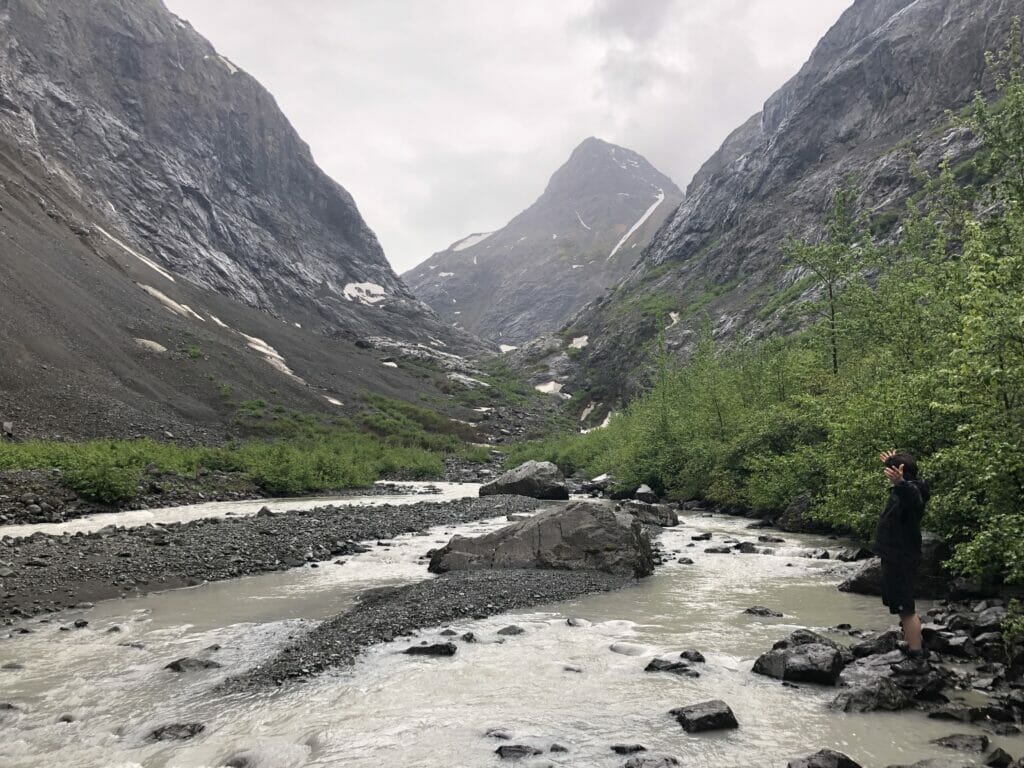
Time well spent
I awoke the next morning to the sound of a soft sprinkle peppering my tent after an inordinately sound night of sleep. Minute muscles, often forgotten about, ached with the pleasure of accomplishment. My dog, Brook, must have felt similar as she stealthily weaseled her way onto my air mattress at some point during the night.
With camp broken down, tent returned to my handlebars, poles strapped to my bike frame, and fueled for the return to the truck, I was not only proud of this new journey, but already looking forward to the chance to return. I look forward to the chance to further my personal connection to the watershed, the lands of historical and cultural significance to the Eklutna Dena’ina peoples, my source for refreshing glacial drinking water and a facilitator of imagination and inspiration.
Learn more about Trout Unlimited’s work to support restoration of the Eklutna River here.



